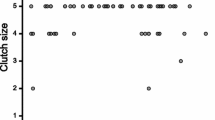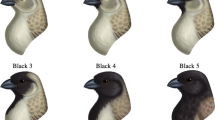Abstract
South temperate songbirds differ from north temperate species in life-history traits, having greater adult survival, smaller clutch size, longer developmental periods and extended parental care. Due to its broad distribution, the House Wren, Troglodytes aedon, is an excellent model to evaluate selective pressures that may influence the maintenance of present clutch size. Here we report data on life-history traits and parental care of socially monogamous House Wrens from a north temperate and a south temperate population. Southern House Wrens exhibited smaller clutch sizes and longer developmental periods than Northern House Wrens; however, we did not find significant differences in adult survival probability between populations, contrary to a critical prediction of the cost of reproduction hypothesis. Our data did not support the hypothesis that smaller clutches are the consequence of greater food limitation in the south. Southern wrens have greater adult body mass but smaller territories; southern nestlings reached a greater proportion of adult body mass 6–7 days before fledgling, and provisioning rates to the nest per nestling were greater in the south. We did not find support for the hypothesis that reduced clutch size is a consequence of limited parental activity at the nest as southern wrens did not reduce parental care during the incubation and nestling stage. Our data better supports the offspring quality hypothesis; southern wrens invest more per nestling than northern wrens as provisioning rates per nestling were significantly higher and developmental periods longer in the south. Published results from Tropical House Wrens suggest that neither food limitation nor nest predation can explain reduced clutches in Central America. We suggest that south temperate and tropical wrens may differ in parental investment strategies as tropical wrens seem to invest even less per nestling than north temperate wrens.
Zusammenfassung
Breitengradunterschiede in ,Life-history traits‘ und elterlicher Brutpflege bei nördlichen und südlichen Hauszaunkönigen der gemäßigten Zone Singvögel der südlich gemäßigten Zone unterschieden sich von Arten der nördlich gemäßigten Zone in den sogenannten Life-history traits, indem sie eine höhere Überlebensrate der Adulten, kleinere Gelege, längere Entwicklungsperioden und eine ausgeweitete elterliche Brutpflege haben. Aufgrund seiner weiten Verbreitung ist der Hauszaunkönig (Troglodytes aedon) ein geeigneter Modellorganismus, um den Selektionsdruck, der die Erhaltung der bestehenden Gelegegröße beeinflussen könnte, zu evaluieren. Wir präsentieren Daten zu life-history traits und elterlicher Brutpflege von sozial monogamen Hauszaunkönigen der nördlich gemäßigten sowie der südlich gemäßigten Population. Südliche Hauszaunkönige haben kleinere Gelege und eine längere Entwicklungsperiode als nördliche Hauszaunkönige. Entgegen der kritischen Prognose zur Reproduktionskosten-Hypothese, fanden wir keine signifikanten Unterschiede in der Überlebenswahrscheinlichkeit der Adulten zwischen den Populationen. Unsere Daten unterstützten nicht die Hypothese, dass kleinere Gelege die Konsequenz aus einer größeren Nahrungsknappheit im Süden sind: südliche adulte Hauszaunkönige sind schwerer, aber haben kleinere Reviere. Die Küken der südlichen Hauszaunkönige erreichen einen größeren Anteil der Adulten-Körpermasse 6–7 Tage vor dem Flüggewerden und die Fütterungsraten pro Nestling waren größer im Süden. Wir konnten keine Hinweise zur Stützung der Hypothese finden, dass eine geringere Gelegegröße die Konsequenz einer begrenzten elterlichen Nestaktivität ist, da südliche Hauszaunkönige während der Bebrütung und der Kükenphase ihre elterliche Brutpflege nicht reduzieren. Deutlich besser stützen unsere Daten die Hypothese zur Qualität der Nachkommen: südliche Hauszaunkönige investieren mehr pro Küken als nördliche Hauszaunkönige, da im Süden die Fütterungsraten pro Nestling signifikant höher waren und die Entwicklung länger dauerte. Publizierte Studien über tropische Hauszaunkönige ergaben, dass weder Nahrungsbegrenzung noch Nestprädation die kleineren Gelege in Zentralamerika erklären können. Wir denken, dass sich südlich gemäßigte und tropische Zaunkönige in ihren elterlichen‚ Investment-Strategien‘unterschieden können, da es scheint, dass tropische Zaunkönige noch weniger investieren pro Küken, als die der nördlich gemäßigten Zone.
Similar content being viewed by others
References
Ashmole NP (1963) The regulation of numbers of tropical oceanic birds. Ibis 103:458–473
Badyaev AV, Ghalambor CK (2001) Evolution of life histories along elevational gradients: trade-off between parental care and fecundity. Ecology 82:2948–2960
Barg JJ, Jones J, Robertson RJ (2005) Describing breeding territories of migratory passerines: suggestions for sampling, choice of estimator, and delineation of core areas. J Anim Ecol 74:139–149
Bennet PM, Owens PF (2002) Evolutionary ecology of birds. Oxford Univ. Press, New York
Butler RE (2000) Stormy seas for some North American song-birds: are declines related to severe storms during migration? Auk 117:518–522
Camfield AF, Pearson SF, Martin K (2010) Life history variation between high and low elevation subspecies of Horned Larks Eremophila spp. J Avian Biol 41:273–281
Carro ME (2012) Dispersión natal y reproductiva de la Ratona Común Troglodytes musculus. PhD Thesis, Universidad de Buenos Aires
Cody ML (1966) A general theory of clutch size. Evolution 20:174–184
IBM Corp (2010) IBM SPSS for windows. Armonk, New York
Drilling NE, Thompson CF (1988) Natal and breeding dispersal in House Wrens (Troglodytes aedon). Auk 105:480–491
Dubois NS, Kennedy ED, Getty T (2006) Surplus nest boxes and the potential for polygyny affect clutch size and offspring sex ratio in House Wrens. Proc R Soc B 273:1751–1757
Garmin (2010) MapSource 6.13.3. Garmin Ltd, Schaffhausen
Ghalambor CK, Martin TE (2001) Fecundity-survival trade-offs and parental risk-taking in birds. Science 292:494–497
Gill SA, Haggerty TM (2012) A comparison of life-history and parental care in temperate and tropical wrens. J Avian Biol 43:461–471
Johnson LS, Kermott LH, Lein MR (1993) The cost of polygyny in the House Wren Troglodytes aedon. J Anim Ecol 62:669–682
Katti M, Price TD (2003) Latitudinal trends in body size among over-wintering Leaf Warblers (genus Phylloscopus). Ecography 26:69–79
LaBarbera K, Llambías PE, Cramer ERA, Schaming TD, Lovette IJ (2010) Synchrony does not explain extrapair paternity rate variation in Northern and Southern House Wrens. Behav Ecol 21:773–780
LaBarbera K, Lovette IJ, Llambias PE (2012) Mating opportunities, paternity, and sexual conflict: paternal care in Northern and Southern temperate House Wrens. Behav Ecol Sociobiol 66:253–260
Lack D (1947) The significance of clutch size, I–II. Ibis 89:302–352
Lack D (1966) Population studies of birds. Clarendon, Oxford
Llambías PE (2012) How do Southern House Wrens Troglodytes aedon musculus achieve polygyny? An experimental approach. J Ornithol 153:571–578
Llambías PE, Fernández GJ (2009) Effects of nest boxes on the breeding biology of Southern House Wrens Troglodytes aedon bonariae in the southern temperate zone. Ibis 151:113–121
Llambías PE, LaBarbera K, Astié AA (2012) Similar parental provisional patterns in a monogamous and a polygynous House Wren population. Condor 114:629–638
Lundberg A, Alatalo RV (1992) The pied flycatcher. Academic Press, San Diego
Martin TE (1996) Life history evolution in tropical and southern temperate birds: what do we really know? J Avian Biol 27:263–272
Martin TE (2002) A new view of avian life-history evolution tested on an incubation paradox. Proc R Soc Lond B 269:309–316
Martin TE, Martin PR, Olson CR, Heidinger BJ, Fontaine JJ (2000) Parental care and clutch sizes in North and South American birds. Science 287:1482–1485
Moreau RE (1944) Clutch size: a comparative study, with reference to African birds. Ibis 86:286–347
Newton I (1998) Population limitation in birds. Academic Press, San Diego
Newton I (2006) Can conditions experienced during migration limit the population levels of birds? J Ornithol 147:146–166
Odum EP, Kuenzler EJ (1955) Measurement of territory and home range size in birds. Auk 72:128–137
Peach WJ, Hanmer DB, Oatley TB (2001) Do Southern African songbirds live longer than their European counterparts? Oikos 93:235–249
Purcell KL, Verner J, Oring LW (1997) A comparison of the breeding ecology of birds nesting in boxes and tree cavities. Auk 114:646–656
Remsen JV Jr, Areta JI, Cadena CD, Jaramillo A, Nores M, Pacheco JF, Pérez-Emán J, Robbins MB, Stiles FG, Stotz DF, Zimmer KJ (2015) A classification of the bird species of South America. American Ornithologists’ Union. http://www.museum.lsu.edu/~Remsen/SACCBaseline.html. Accessed 6 Apr 2015
Ricklefs RE (2010) Parental investment and avian reproductive rate: Williams’s principle reconsidered. Am Nat 175:350–361
Russell EM, Yom-Tov Y, Geffen E (2004) Extended parental care and delayed dispersal: northern, tropical and southern passerines compared. Behav Ecol 5:831–838
Sillet TS, Holmes RT (2002) Variation in survivorship of a migratory songbird throughout its annual cycle. J Anim Ecol 71:296–308
Skutch AF (1949) Do tropical birds rear as many young as they can nourish? Ibis 91:430–455
Skutch AF (1985) Clutch size, nesting success, and predation on nests of neotropical birds, reviewed. Ornithol Monogr 36:575–594
Soukup SS, Thompson CF (1997) Social mating system affects the frequency of extra-pair paternity in House Wrens. Anim Behav 54:1089–1105
Stutchbury BJM, Morton ES (2001) Behavioral ecology of tropical birds. Academic Press, San Diego
Tieleman BI, Dijkstra TH, Lasky JR, Mauck RA, Visser GH, Williams JB (2006) Physiological and behavioral correlates of life-history variation: a comparison between tropical and temperate zone House Wrens. Funct Ecol 20:491–499
Tuero DT, Fiorini DV, Reboreda JC (2007) Effects of Shinny Cowbird Molothrus bonariensis parasitism on different components of House Wren Troglodytes aedon reproductive success. Ibis 149:521–529
White GC, Burham KP (1999) Program mark: survival estimation from populations of marked animals. Bird Study 46:120–139
Williams GC (1966) Natural selection, the cost of reproduction, and a refinement of Lack’s principle. Am Nat 100:687–690
Yom-Tov Y (1994) Clutch size in passerines of southern South America. Condor 96:170–177
Young BE (1994) Geographic and seasonal patterns of clutch-size variation in House Wrens. Auk 111:545–555
Young BE (1996) An experimental analysis of small clutch size in Tropical House Wrens. Ecology 77:472–488
Acknowledgments
We thank David W. Winkler for helpful comments on the manuscript, Valentina Ferretti, Myriam Mermoz and Pablo Rodriguez for help in the field, and Mario Beade and Bob Johnson for logistic support. Economic support was provided to PEL by the Department of Ecology and Evolutionary Biology at Cornell University, the Cornell Laboratory of Ornithology, Mario Einaudi Center for International Studies, Cornell Chapter of Sigma Xi, The Scientific Research Society, American Ornithologist Union and Andrew W. Mellon Student Research Grant. Support to GJF and MEC was provided by the University of Buenos Aires (grant 20020090200117) and CONICET grants (PIP11220090100011). All methods used in the present study meet the ethical requirements for science research and comply with the current laws of the countries in which they were performed. We thank two anonymous reviewers for their helpful comments on an earlier version of this manuscript.
Author information
Authors and Affiliations
Corresponding author
Additional information
Communicated by C. G. Guglielmo.
Rights and permissions
About this article
Cite this article
Llambías, P.E., Carro, M.E. & Fernández, G.J. Latitudinal differences in life-history traits and parental care in northern and southern temperate zone House Wrens. J Ornithol 156, 933–942 (2015). https://doi.org/10.1007/s10336-015-1217-2
Received:
Revised:
Accepted:
Published:
Issue Date:
DOI: https://doi.org/10.1007/s10336-015-1217-2




